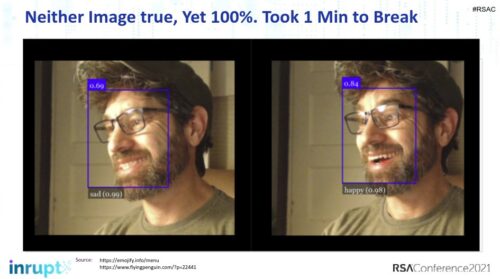
An old story from NPR came to mind when I was hacking some AI systems meant to read facial expressions.
Darwin hypothesized making faces probably had some survival advantage… [and then neuroscientists Adam Anderson and Joshua Susskind from the University of Toronto were able to prove] fear expression opens up, speeds up and increases sensory information about the environment. In contrast, an expression of disgust – a scrunched up face – does just the opposite. Disgust shuts our sensory information, the researchers found. You see and smell less.
It often shows up in power dynamics.
…ideas of license and obligation translate into the micro-reality of facial expression.
Some of it is common sense stuff, such as politicians try hard to make their face look excited if their constituents value someone being easily excited.
…the more a particular country’s culture values excitement, the more its political leaders show enthusiastic smiles. On the other hand, when the specific culture emphasizes calm, those leaders show more reserved smiles.
Of course the problem becomes that 13 of those political smiles might be indicators of risk and danger.
Of 19 different types of smile, only six occur when we’re having a good time. The rest happen when we’re in pain, embarrassed, uncomfortable, horrified or even miserable. A smile may mean contempt, anger or incredulity, that we’re lying or that we’ve lost. […] “When bonobo chimpanzees are afraid they’ll expose their teeth and draw their lips back so that their gums are exposed,” says Zanna Clay, a primatologist at the University of Birmingham. The ‘silent bared teeth display’ looks so much like a smile it’s often featured on birthday cards, but in chimpanzees it’s a gesture of submission, used by low-status individuals to appease more dominant members of the group.
That certainly sheds light on why men in American politics would so often tell women and foreign politicians to smile more. The smile they want to see is of appeasement, accepting domination.
Every woman I know seems to have a story about being told to smile. Mine involves my eighth-grade gym teacher, who decided when I was 13 that I wasn’t smiling enough in his class. Twice a week he would walk down the line of us, taking attendance, and stop in front of me. “Smile!” he’d say. “I like it when you smile!” The first few times I smiled at him involuntarily, then, furious at myself, rearranged my face into a scowl. Later, I came to expect it. I would clench my teeth as his sneakers squeaked closer, steeling my face to stay rigid and calm. Smile! You know I like it when you smile! He’d stand over me, waiting with his clipboard, until I finally gave in.
Meanwhile, Russians apparently treat smiling as a sign of stupidity, Chinese look upon smiling as anger or even guilt.
The bottom line is the more that emerging “intelligence” systems are expected to detect emotions, the more I suspect actual intelligence will defeat such horribly primitive, yet expensive and powerful, intentions. Facial expression training is like bringing a knife to an AI fight, where the knife wins.